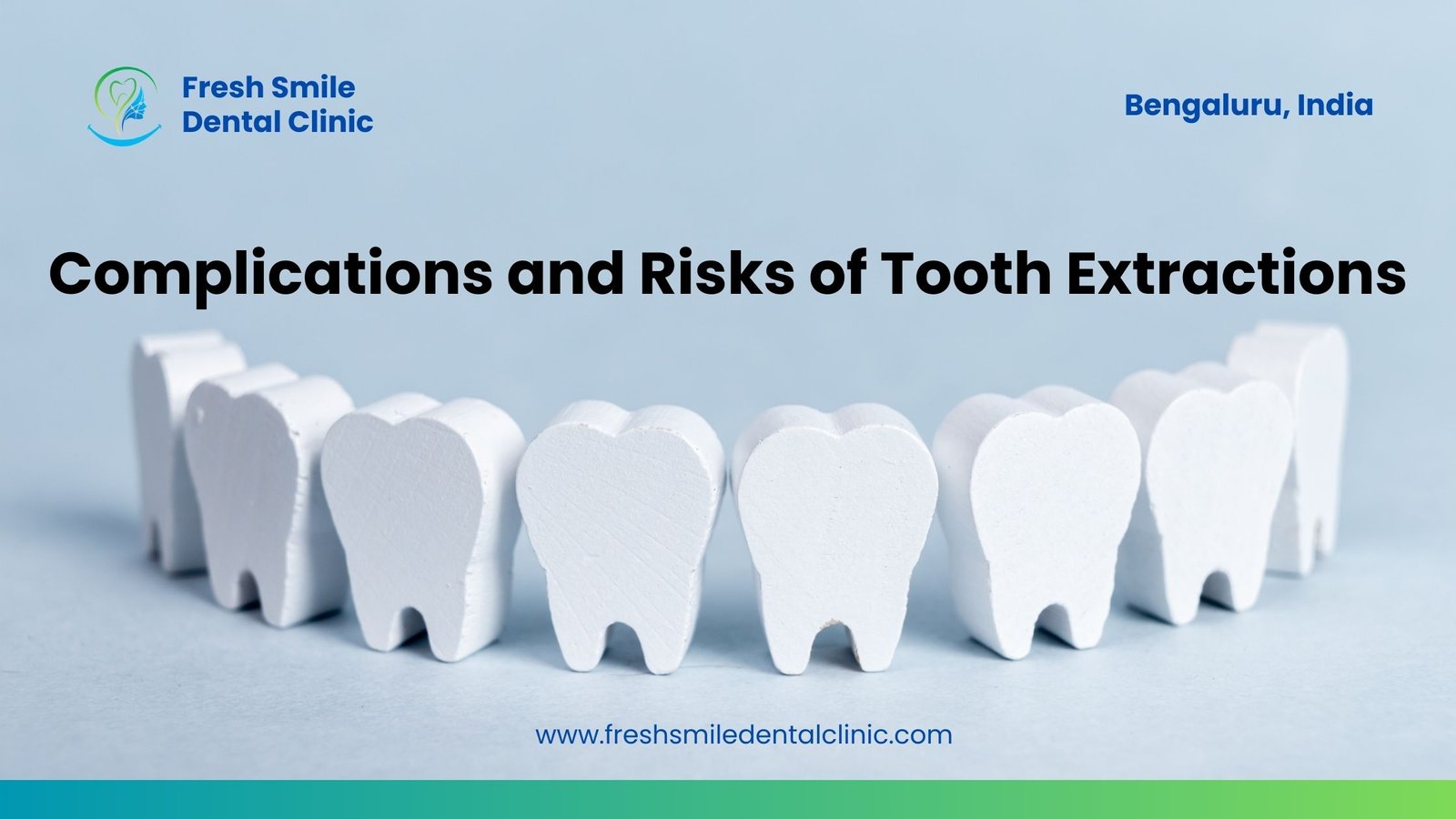Complications and Risks of Tooth Extractions: A Comprehensive Guide
Tooth extractions are common dental procedures performed worldwide to alleviate pain, address oral health issues, and enhance overall well-being. While these extractions are generally safe and successful, there are inherent complexities that can lead to complications and risks. Understanding these potential complications, their causes, and the steps to minimize them is crucial for both patients and dental professionals. In this comprehensive guide, we delve into the complications and risks associated with tooth extractions, providing valuable insights for readers in India.
The Need for Tooth Extractions
Before delving into the complications, it’s essential to understand why tooth extractions are performed. There are several reasons, including:
- Tooth Decay: Severely decayed teeth that cannot be restored through dental treatments often require extraction to prevent the spread of infection.
- Dental Infection: When a dental infection progresses to the point where it cannot be effectively treated with antibiotics or a root canal, extraction may be necessary.
- Impacted Wisdom Teeth: Impacted wisdom teeth can lead to pain, infection, and damage to adjacent teeth. Removing these impacted teeth is often the best solution.
- Orthodontic Treatment: In some cases, orthodontic treatment may necessitate the extraction of certain teeth to create space for tooth alignment.
Common Complications and Risks of Tooth Extractions
- Dry Socket (Alveolar Osteitis): Dry socket is a painful condition that occurs when the blood clot that should form after an extraction is dislodged or dissolves prematurely, exposing the underlying bone and nerves. It can lead to severe pain and requires immediate dental attention.
- Infection: Infection at the extraction site is a risk, although it’s relatively rare. Symptoms may include pain, swelling, and fever, and treatment involves antibiotics and professional dental care.
- Nerve Damage: While uncommon, nerve damage can occur during lower wisdom tooth extractions. This can lead to numbness or tingling in the lower lip, chin, or tongue, known as paresthesia. In most cases, this condition is temporary, but in rare instances, it can be permanent.
- Fractured Teeth or Roots: During extractions, teeth or roots can fracture, leading to potential complications. In such cases, the remaining fragments may need to be removed surgically.
- Bleeding: Some bleeding is normal after an extraction, but excessive or prolonged bleeding may occur due to various factors. It is crucial to control bleeding to prevent complications.
- Sinus Issues: Upper back tooth extractions, especially in the upper jaw, are close to the sinuses. In some cases, a communication between the mouth and sinus can occur, resulting in sinus issues. This can often be resolved with additional dental procedures.
- Jaw Fractures: Extremely rare, jaw fractures can occur during surgical extractions, especially in individuals with brittle or weakened jawbones.
Minimizing Complications and Risks of Tooth Extractions
Minimizing complications and risks is a shared responsibility between the patient and the dental professional. Here are some essential steps:
- Pre-Extraction Assessment: A thorough evaluation of the patient’s medical history, current medications, and dental condition is essential before scheduling an extraction.
- Informed Consent: Patients should be fully informed about the procedure, potential risks, and post-extraction care. Informed consent is crucial.
- Follow Pre-Extraction Instructions: Patients should adhere to any pre-extraction instructions provided by the dental professional, such as fasting, discontinuing certain medications, or abstaining from smoking.
- Post-Extraction Care: Following the extraction, patients must adhere to post-extraction care instructions, including proper wound care, pain management, and dietary restrictions.
- Regular Follow-Up: Scheduled follow-up appointments are essential for monitoring the healing process and addressing any emerging issues promptly.
Things to Avoid after Tooth Extraction :
After a tooth extraction, it’s essential to follow post-operative care instructions to promote proper healing and prevent complications. Here are things to avoid after a tooth extraction:
- Spitting: Avoid vigorous spitting or rinsing your mouth on the day of the extraction. This can dislodge the blood clot, leading to dry socket.
- Touching the Extraction Site: Do not touch the extraction site with your fingers or tongue. This can introduce bacteria and increase the risk of infection.
- Drinking Through a Straw: Drinking through a straw creates suction in your mouth, which can also dislodge the blood clot. Avoid straws for at least the first 24 hours.
- Smoking: Smoking introduces harmful chemicals and bacteria into the mouth, increasing the risk of infection and delaying healing. It’s best to abstain from smoking for several days.
- Alcohol: Alcohol can interfere with the healing process and interact with pain medications. Avoid alcohol for at least 24 hours or as recommended by your dentist.
- Hot or Spicy Foods: Hot, spicy, or hard foods can irritate the extraction site. Stick to a soft diet, including cool or lukewarm foods for the first few days.
- Strenuous Activity: Avoid strenuous physical activity for a few days, as it can increase blood flow to the extraction site, leading to bleeding and discomfort.
- Oral Hygiene Near the Extraction Site: While it’s crucial to maintain oral hygiene, be gentle when brushing and flossing. Avoid the extraction site for the first 24 hours. Instead, rinse your mouth with warm saltwater.
- Over-the-Counter Mouthwashes: Some mouthwashes contain alcohol and other chemicals that can irritate the extraction site. Use a prescribed or recommended mouthwash, if necessary.
- Skipping Medication: If your dentist prescribes pain medication or antibiotics, be sure to take them as directed. Skipping doses can lead to increased pain or infection.
- Ignoring Post-Op Care Instructions: Follow all post-operative care instructions provided by your dentist. These are tailored to your specific situation and are essential for a smooth recovery.
- Ignoring Complications: If you experience severe or worsening pain, persistent bleeding, signs of infection (fever, swelling), or other unusual symptoms, contact your dentist promptly. Ignoring complications can lead to more significant problems.
Remember that proper post-operative care is crucial to ensure a comfortable and complication-free recovery after a tooth extraction. If you have any concerns or questions about your specific case, consult with your dentist for guidance and personalized advic
Conclusion: Complications and Risks of Tooth Extractions
Tooth extractions, although considered routine dental procedures, are not devoid of potential complications and associated risks. The importance of understanding these complexities, their underlying causes, and the measures to mitigate them cannot be overstated. In India, where dental health is of paramount significance, comprehensive knowledge about tooth extraction complications and the ways to prevent them is essential for both patients and dental professionals.
The Rationale for Tooth Extractions
Before delving into the intricacies of potential complications, it’s pivotal to appreciate the reasons behind tooth extractions. These procedures serve various critical purposes, including:
- Addressing Severe Tooth Decay: Teeth that have succumbed to severe decay beyond repair through conventional dental treatments often necessitate extraction. This is a crucial step to prevent the spread of infection and maintain oral health.
- Tackling Dental Infections: Dental infections that progress to an advanced stage, rendering antibiotics or root canal treatments ineffective, may compel the need for extraction.
- Managing Impacted Wisdom Teeth: Impacted wisdom teeth are a common issue, often causing pain, infection, and even damage to neighboring teeth. The removal of impacted wisdom teeth is frequently the most effective solution.
- Facilitating Orthodontic Treatment: In orthodontic cases where space is limited or teeth are misaligned, specific extractions can create the necessary room for alignment and correction.
Identifying Common Complications and Risks
To understand the complexities and potential pitfalls of tooth extractions, it is crucial to recognize some common complications and associated risks:
- Dry Socket (Alveolar Osteitis): Dry socket is a post-extraction condition marked by intense pain. It occurs when the blood clot that should form in the socket after extraction is dislodged or dissolves prematurely. This exposes the underlying bone and nerves, leading to severe discomfort and the necessity for immediate dental intervention.
- Infection: Infection at the extraction site is relatively rare but can manifest as pain, swelling, and fever. Treatment involves a combination of antibiotics and professional dental care to mitigate risks.
- Nerve Damage: Although infrequent, nerve damage can occur during the removal of lower wisdom teeth. This may lead to temporary numbness or tingling in the lower lip, chin, or tongue, a condition known as paresthesia. In most cases, it is temporary, but there are rare instances of permanent damage.
- Fractured Teeth or Roots: While extracting teeth, fractures may occur in the tooth or its roots, presenting potential complications. In such instances, any remaining fragments may need to be extracted surgically.
- Excessive Bleeding: While some bleeding post-extraction is normal, its excess or prolonged occurrence may result from various factors. Effectively controlling bleeding is crucial to prevent complications.
- Sinus Issues: Upper back tooth extractions, particularly in the upper jaw, are proximate to the sinuses. In some cases, a communication between the oral cavity and the sinus can arise, causing sinus problems. This concern can often be resolved with additional dental procedures.
- Jaw Fractures: Jaw fractures, although extremely rare, can take place during surgical extractions, especially in individuals with brittle or weakened jawbones.
Mitigating Complications and Risks
Minimizing the potential complications and risks associated with tooth extractions requires a collaborative effort between the patient and the dental professional. Here are the essential steps to consider:
- Pre-Extraction Assessment: A comprehensive evaluation of the patient’s medical history, current medications, and dental condition is indispensable before scheduling an extraction. This assists in identifying potential risk factors and tailoring the procedure to the individual’s needs.
- Informed Consent: Patients must receive clear and detailed information about the procedure, potential risks, and post-extraction care. Informed consent forms the cornerstone of a secure and successful extraction experience.
- Adherence to Pre-Extraction Instructions: Patients should closely follow any pre-extraction instructions provided by the dental professional. These instructions may include fasting, discontinuing certain medications, or abstaining from smoking, among other guidelines.
- Post-Extraction Care Compliance: After the extraction, it is paramount that patients adhere to post-extraction care instructions. These guidelines encompass proper wound care, pain management, and dietary restrictions, all of which play a pivotal role in the recovery process.
- Scheduled Follow-Up: Regular follow-up appointments are crucial to monitor the healing process and address any emerging issues promptly. This ensures that any complications or concerns are identified and managed early.
An Informed Approach to Dental Healthcare
In India, where oral health is a vital aspect of overall well-being, understanding the intricacies of tooth extraction complications is indispensable. Patients and dental professionals must work hand-in-hand to ensure a safe and successful extraction experience.
Dental care is a collaborative effort, where informed decisions, proactive patient engagement, and the expertise of dental professionals are essential. This comprehensive guide serves as a valuable resource for individuals seeking a deeper understanding of tooth extraction complications and the strategies to mitigate associated risks. By upholding these principles and embracing the principles of informed dental healthcare, India’s population can continue to safeguard and prioritize their dental health effectively.
Read also:
Teeth and Gum Care for Infants and Toddlers.
Crown and Bridge Restorations.
Composite Fillings vs Amalgam Fillings.
Managing Dental Anxiety in Children.
Fluoride Treatments and Dental Sealants: Against Tooth Decay in Kids.
Treating Gum Disease with Laser Therapy.
Precision and Accuracy in Laser Dentistry.
11 things an adult can do to maintain good oral health.
11 things that makes your teeth weak.
11 Nighttime Tips for Maintaining Healthy Teeth and Gums.




